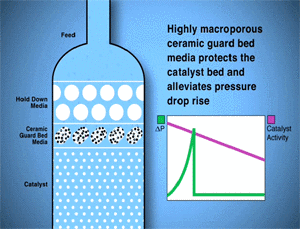Protect Catalyst Beds with Ceramic Guard Bed Media
Featured Product from Saint-Gobain NorPro

The growing use of a wider variety of heavy crudes, along with the increasing demand for cleaner fuel products, has accelerated the need for this effective method of catalyst bed protection. More and more refineries are turning to guard bed technologies to meet today's challenges to profitability.
A number of factors can cause bed plugging. Most common is "tramp iron," or iron particles collected by the feed from upstream equipment, including pipelines and heat exchangers. Other solid material carried by the feed can contaminate the bed as well. Soluble iron compounds, such as iron porphyrins, react with sulfur in the feed to form complex polymeric iron sulfide gums that accumulate on the catalyst bed. The scope of the problem grows as refineries continue to their move towards heavier feedstocks. Upstream additives also react with feed components to form solid particles or precipitates that can plug the catalyst bed.
The solution: MacroTrap® guard bed media
Layers of highly macroporous MacroTrap media graded on top of the catalyst bed effectively removes particulates and reduces the formation of iron sulfide gums. The feed flows around and through the MacroTrap media's interconnecting pores. Particulates form the feed fall out of the stream inside these pores, where they remain deposited without increasing the pressure drop of the system.
Iron sulfide gums form on the extra surface within the macropores of the guard bed media rather than accumulating on the catalyst. Once iron has deposited in the macropores, the guard bed media can act as a mild demetallization catalyst to remove vanadium, nickel and other heavy metals that can poison subsequent catalyst beds.
View product videos to demonstrate the workings of MacroTrap guard bed media.











